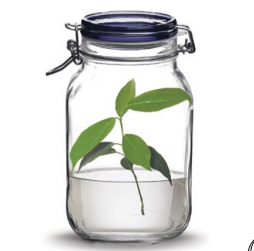What is a forest?
Although ‘forest’ is a commonly used word, it is not easy to clearly define what it is. There are more than 800 different definitions for a forest around the world! But the most recognized approach to identify a forest, used also by the United Nations Food and Agriculture Organization (FAO), includes such indicators as: 1) minimum height of trees of 5 m, 2) at least 10% for crown cover (proportion of the ground shaded by the crown of the trees) and 3) a minimum forest area size of 0.5 hectares. According to this definition there are just under 4 billion hectares of forests on Earth, covering in all about 30% of the total land area. About half of the world’s forest areas are located in three countries: Russia, Canada and Brazil.
Types of forests
Forests are usually classified in terms of the predominant tree species (broadleaf, coniferous (needle-leaved), or mixed) and their leaf longevity (whether they are evergreen or decidious).
The main forest types (see Fig. 2.3.1) are:
• Boreal forests (taiga) are generally evergreen and coniferous.
• Temperate forests include broadleaf deciduous forests, evergreen coniferous forests and a
mix of both types. Warm temperate zones support broadleaf evergreen forests.
• Mediterranean forests are generally composed of evergreen broadleaf and sclerophyll trees.
Sclerophyll means ‘hard-leaved’ in Greek, as such trees usually have small, dark leaves covered with a waxy outer layer to retain moisture in the dry summer months. Coniferous forests also occur in this zone.
• Tropical and sub-tropical forests include moist broadleaf forests, dry broadleaf forests and
coniferous forests.

Why are forests dependent on the climate?
The life of the forest and its geographic distribution depend on climatic conditions, especially air temperature and the amount of precipitation. Only in some places of our planet the climate is suitable for forests to develop. For example, the location of the northern-most forest line depends on the average annual air temperature. Where it becomes too cold, boreal forest is replaced by tundra. However, air temperature, especially on plains, does not change abruptly, but gradually. So the border of the forest and tundra becomes a transition zone, where areas of both tundra and forest are found. This transition zone is called forest-tundra (Fig. 2.3.2).
The southern line of temperate forests, where forests give way to grassland (steppe) and semidesert, is determined by rainfall. In hot conditions, plants and trees are constantly losing moisture from their leaves in order to keep cool. If rainfall in the summer is scant, there is not much moisture in the soil, and trees have difficulty drawing it upwards as high as their crown. Because the air is warm and precipitation is limited, low herbaceous plants are at an advantage and the landscape becomes steppe. Relief, soil quality, water bodies and human activity are also important for determining forest cover. The share of forest diminishes in regions where much of the land has been put to work in the economy.
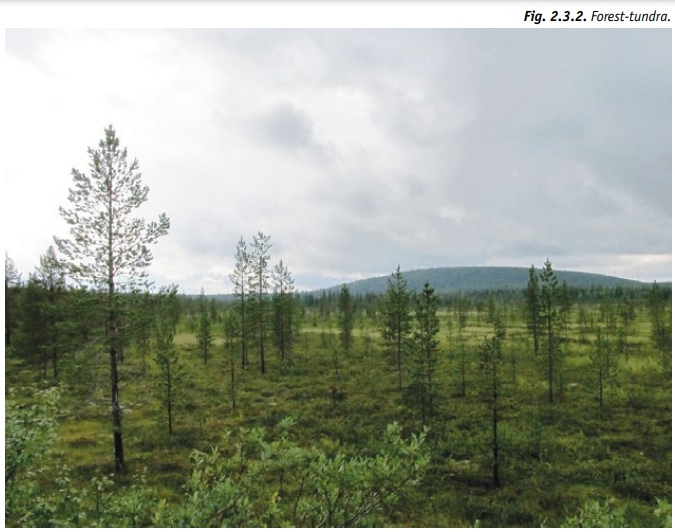
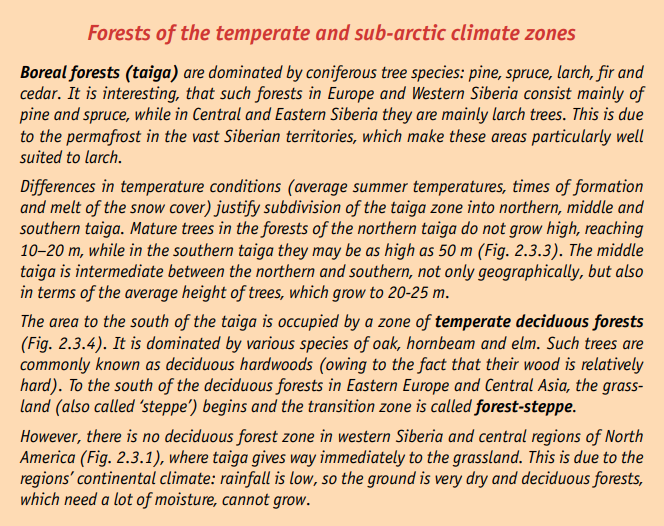
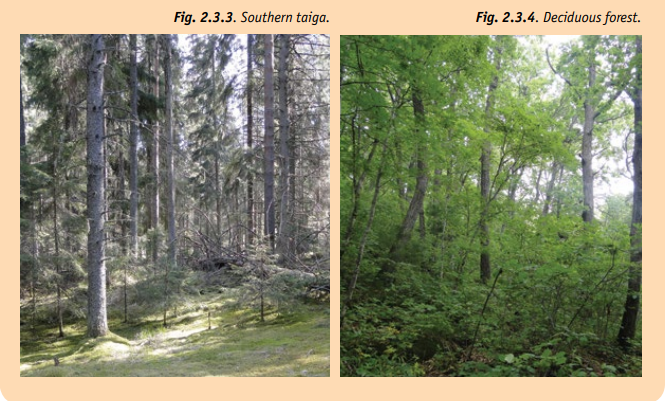
Does the climate change taking place today have an impact on forests?
Are forests affected by the warming of the climate, which is currently occurring? Yes, they are! Climate change will have many widely varying effects on trees and tree species composition within forest ecosystems. As the climate continues to change, trees will either have to adapt to the new conditions or migrate to more suitable locations.
Changes associated with global warming are particularly apparent on the northern boundary of boreal forests. In polar regions, trees and shrubs rise are moving higher up the mountain slopes, gradually usurping the place of mountain tundra (Fig. 2.3.5). The upper boundary of larch trees on mountain slopes of the Polar Urals (Russia) has moved upwards by 35–40 m in the last 80–90 years and by 50–80 m in some regions. Shrubs are now growing more than 50 m higher up on slopes in the Khibiny Mountains on the Kola Peninsula (Russia), and an intensive growth
of shrubs, particularly willows, has been observed in Scandinavian tundra zones.
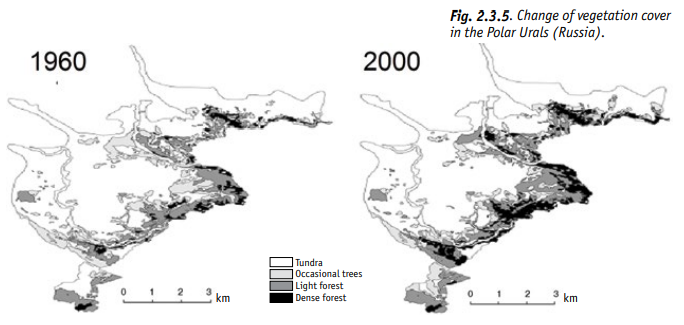
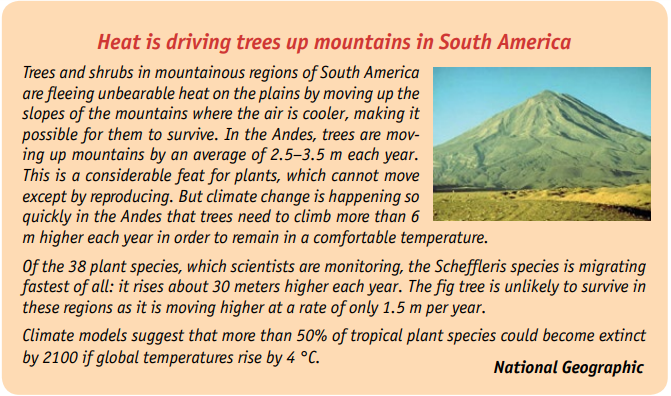
The southern boundary of the temperate forests is also changing. Oak forests are gradually disappearing in the forest-steppe and steppe zones due mainly to summer droughts. In the region around Lake Baikal, by contrast, pine forests are advancing into steppe ecosystems, due to increased precipitation. So the southern forest line is shifting because of changes in the moisture levels rather than because of the increase of temperature.
The areas of Russian forests that are occupied by particular tree species have changed in recent decades and scientists believe that this is largely due to climate warming. For example, oak forests have diminished in southern regions, but are gaining ground further north, on the border between deciduous forests and the northern taiga.
Spruce forest (Fig. 2.3.6) is in retreat in nearly all parts of Russia. The root system of spruce trees is close to the surface, which makes the tree highly sensitive to increase in the frequency and duration of droughts. At the same time, many regions of Russia are seeing an increase in the area of birch forests. This phenomenon is well known to forestry specialists: it is due to the fact that, after a fire or the felling of coniferous trees, birch and other small deciduous species initially appear in their place , and some time is needed before new coniferous trees appear and
begin to displace birch, aspen and alder. However, in recent decades, this last stage has not been occurring: conifers seem unable to regain ground lost to birch forest.
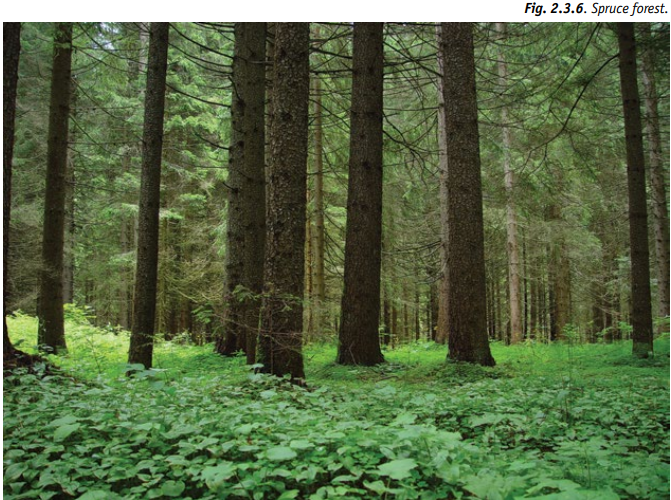
Most forecasts predict that forests in northern parts of Eurasia and North America will be more affected by global warming than forests elsewhere in the world, as their northern and southern boundaries are displaced. An increase of temperature by 2 °C will cause an increase in the total area of forest cover in Europe due to its advance of taiga into the present tundra zone. However, an increase of temperature by 4 °C will cause the southern forest boundary to retreat northward and this effect will be greater than the northward advance into the tundra zone (Fig. 2.3.7).
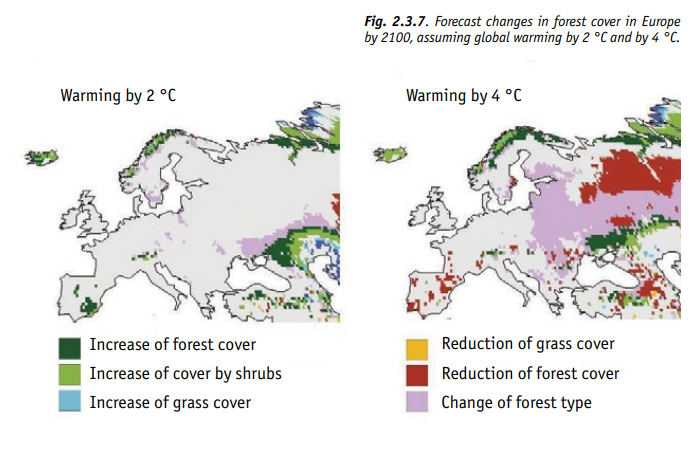
Deforestation caused by climate change will affect almost the whole of Eastern Europe and Western Siberia. This is a worrying forecast, showing how serious a phenomenon the disappearance of forests may be if the worst-case scenario for global warming is realized.
Destruction of forests by fires, pests and extreme weather
Another major threat to forests associated with climate change comes from large-scale fires and plagues of pests caused by hot weather in summer. Heat and other extreme weather events are often directly responsible for the destruction of forests.
Forest fires are usually started accidentally by people. But they can only take hold in certain conditions, namely, when the weather remains hot and dry for a number of days or weeks. The forest floor of dead leaves, pine needles, small branches, mosses, lichens and grasses growing under the forest canopy then becomes dry and catches light easily, and the fire can spread over large areas. This is called a ground fire.
When fire spreads in coniferous forests it often reaches the crowns of the trees. Pine needles and the small branches of fir and pine trees contain large amounts of resinous substances, so living trees can easily catch fire. A crown fire is the most dangerous and destructive, and can lead to the complete loss of an area of forest (Fig. 2.3.8)!
Fires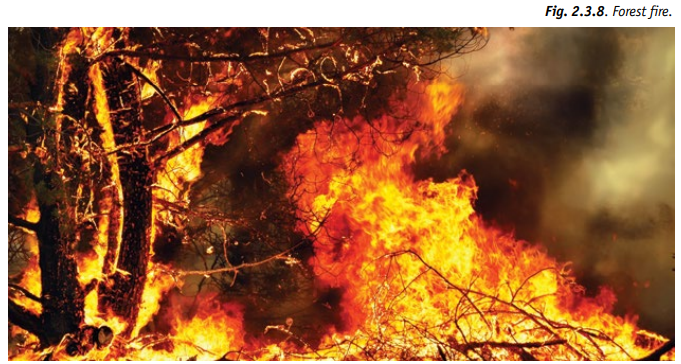
The unusually hot summer of 2010 in the central part of European Russia weakened conifers that are accustomed to very different conditions. Such weakened trees are easy prey for many species of insects that live under the bark. In years when temperature and humidity levels are normal the population numbers of such insects are controlled by other species (insect and bird predators). But if the population of bark beetles becomes too large, large tracts of forest may perish! The dried-up trees first lose their needles, and then their bark. Various fungi that attack wood go to work on the roots, which are eventually unable to support the trees. Strong winds can then blow the trees down, one after another (Fig. 2.3.9). First birds and then squirrels desert the forest where they can no longer make their harvest of cones. Martens then move elsewhere in search of better hunting. The green forest floor, made up of lilies of the valley and wood sorrel, which flourished thanks to the protection from direct sunlight afforded by the trees, is replaced by thickets of reed grass, raspberry bushes and nettles. In short, the entire range of species is changed!
All is not lost: the displaced species can return. As happens after a serious 
fire, a forest of spruce will fully restore itself after one or two hundred years. But only provided that such forest has remained intact elsewhere with all of its inhabitants, and only provided that the abnormal fluctuations of temperature do not recur. Other extreme weather events – hurricane-force winds and tornadoes – can destroy forests as effectively as
drought, by blowing down the trees (Fig. 2.3.10). Heavy rains can also do much damage by washing away the soil or killing trees through prolonged water-logging. Heavy falls of wet snow and the large-scale formation of ice also harm trees, and heavy showers of hail damage bark on the branches, weakening the tree and causing it to dry out.

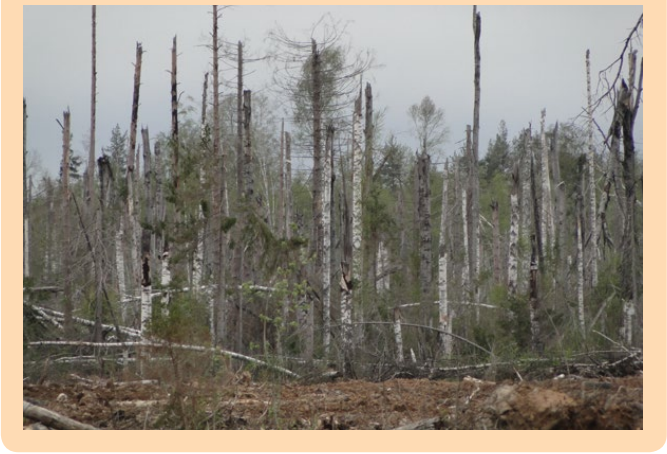
The history of glaciation, current scientific evidence and forecasts show that forests and other natural ecosystems can adapt to the most varied climatic conditions. But this adaptation is mainly related to migration – that is, to changes in the boundaries of natural areas and vegetation types. During periods of glaciation, forests only survived on a relatively small area, and larges expanses of Eurasia were covered by tundra and tundra-steppe. When the climate grew warmer, forest regained its status as the dominant vegetation type. But warming of the climate today is happening too quickly, threatening not gradual, but catastrophic change of vegetation types, through the large-scale drying-out of forests with high risk of forest fires.
This makes it highly important not to let global warming reach extremes, and to work for a gradual stabilization of the climate change on the planet!
How do forests affect climate?
We know now how climate and climate change affect forests. But this relationship also holds in the other direction: forests have an impact on climate! For example, green forest changes the reflection of sunlight by the Earth’s surface, so it affects the amount of heat absorbed by Earth. The difference in temperature between the forest areas and areas without forest is especially noticeable in the winter. The sun’s rays are reflected from the treeless, snow-covered plains, but the dark spaces of boreal forests reflect less and absorb more of the sun’s light. Forest helps to retain moisture in the soil and affects evaporation, making the regional climate milder and wetter.
Snow cover remains for longer in the forest, lessening sharp changes of temperature that occur in the springtime and reducing the risk of spring flooding by rivers.
But what makes forests particularly important for climate is the carbon cycle. Carbon dioxide released into the atmosphere by the burning of fossil fuels is the main cause of the global warming that is occurring today. Forests play the vital role of absorbing carbon dioxide from the atmosphere and retaining carbon in the form of various organic substances.
You may know that green plants absorb carbon dioxide and produce oxygen. This process is called photosynthesis, and it is powered by the energy of sunlight. Forests represent a dens concentration of green plants (trees, shrubs and grass) and it is generally believed that forests are vital for enriching our planet’s atmosphere with oxygen. You often hear the term “green lungs of the planet” used on TV and in newspapers to describe forests. Absorption of carbon
dioxide and emission of oxygen are the two sides of the single process of photosynthesis, so you would think that forests must remove carbon dioxide from the atmosphere. But it is not that simple. To understand the process of exchange of carbon dioxide between the forest and the atmosphere, we need to understand how the forest stores carbon – the element that joins with oxygen to form carbon dioxide. All organic substance contains carbon. For example, nearly half of the weight of dry wood is carbon.

What is a carbon pool?
Any part of the ecosystem that contains significant amounts of organic matter is a store of carbon. Scientists call such stores ‘carbon pools’. There are four main carbon pools in the forest ecosystem: 1) phytomass (the weight of living plants); 2) dead wood; 3) litterfall (dead leaves and branches on the forest floor), 4) organic matter
in the soil.
The phytomass pool consists of living plants: the trunks, branches, roots leaves and needles of trees and shrubs,
the leaves and roots of grass and moss (Fig. 2.3.11). As a rule, tree trunks account for most of the phytomass, but
moss is also a major part of it in northern boreal and marshy pine forests.
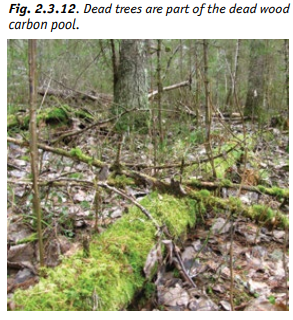
The dead wood pool consists of dead trees and roots. The death of trees in the forest is called ‘attrition’ and it occurs naturally as the growing trees compete for sunlight. The smaller trees are left in shadow by the larger trees and gradually wither because they do not receive enough light for photosynthesis. This is why young forest is much
thicker than old forest. But attrition can also occur in various other situations: it can be caused by forest fires, droughts, forest pests, and man-made pollution. In forests that are affected in one or several of these ways, the carbon pool in dead wood may exceed the pool in living wood.
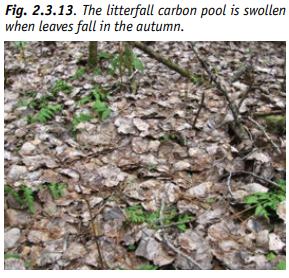 Litterfall is made up of relatively small fragments of organic matter lying on the soil surface (Fig. 2.3.13). It consists mainly of dry leaves and pine
Litterfall is made up of relatively small fragments of organic matter lying on the soil surface (Fig. 2.3.13). It consists mainly of dry leaves and pine
needles, small dry twigs, flower petals, cones and other fragments that have fallen from living plants. In deciduous forests replenishment of the litterfall pool is most intensive during the autumn leaf fall, while in boreal forest it occurs more evenly through the seasons.
Soil pool in the forest contains significant amounts of carbon. The soil is a mixture of minerals and of organic matter, mainly ‘humus’, which is a
dark- coloured substance created by the gradual break-down of plant residues (litterfall, dead wood and dead roots). Carbon accounts for 58% of the make-up of humus, which is a higher share than in phytomass. The darker the soil, the more carbon it contains (Fig. 2.3.14).
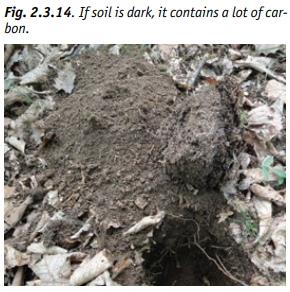
In boreal forests phytomass contains 21% of the carbon stock, dead wood 4%, litterfall 3%, and 72% is in the soil. So, in these forests, carbon is concentrated in the soil.
These shares are quite different in tropical forests, where living and dead organic matter accounts for 50% of carbon.
Why is the difference so large? In boreal forests most of the dead plants are broken down by fungi and bacteria, and this process occurs slowly. It takes many decades for the trunks of large dead trees to disappear. Because of this, the forest accumulates large pools of dead organic matter – dead wood, litterfall and humus in the soil. In tropical forest a large part of the litterfall and dead wood is consumed by animals, especially termites. This speeds up the rate of decomposition and reduces the contribution of dead organic matter to the total amount of carbon in the ecosystem.

Carbon budget
Now that we know all about carbon pools in the forest ecosystem, let’s see how these pools are connected with each other and with the atmosphere (Fig. 2.3.15). Scientists call this system of connections a ‘carbon budget’, because it is similar to the financial budget of a country, a company or a family, where what comes in (income) has to be matched with what goes out
(spending). The only ‘income item’ in the forest ecosystem is photosynthesis. The sum of photosynthesis creates organic substance. The first consumers of this substance are plants themselves: nearly half of the substance created by photosynthesis is used by the plants when they breathe, releasing the carbon from the substance back into the atmosphere.
The remainder of the substance is called ‘net photosynthesis’: it replenishes the phytomass pool.
Various living organisms that inhabit a forest consume the living substance of plants: caterpillars and other insects feeding on the leaves of trees; birds and rodents collecting fruits and seeds, and hoofed animals that eat grass and young branches.
In taiga and in temperate forests a large part of the plant life dies naturally (when a plant withers and dies completely or when it drops its leaves and twigs) and is then consumed by fungi and bacteria (Fig. 2.3.16). This replenishes the dead wood and litterfall carbon pools. When fungi and bacteria respire the carbon of organic matter binds with oxygen and returns to the atmosphere as carbon dioxide. This happens as dead wood and litterfall decomposes. A modest part of these pools is transformed into humus and replenishes the soil carbon pool (this process is called humification). Carbon also enters the soil from living plants in the form of organic substances that are secreted by the roots.
Organic matter in the soil is also broken down by fungi and bacteria with the release of carbon dioxide into the atmosphere. A part of the carbon is washed out of the ecosystem by groundwater and surface water: you must have seen autumn leaves being carried away by forest streams.
Forests that contain many mature and old trees absorb the same amount of carbon dioxide from the atmosphere as they release back into it. Carbon pools in such a forest remain constant over
time. They are like swimming pools: full to the brim and incapable of taking more, except that they are full to the brim with carbon and not water. But that is not to say that mature forests don’t play a role in regulating the gas composition of the atmosphere. The point is only that they are no longer actively absorbing, and have instead become the keepers of ‘stored’ carbon, i.e. carbon that can no longer contribute to the greenhouse effect. The carbon budget of young, growing forests is different from that of mature forests. Young
forests accumulate carbon, removing it from the atmosphere. This carbon builds up in pools. So it is only young forests that deserve to be called the
‘green lungs’ of the planet.
Differences in the impact of forests on the atmosphere
We have seen how young and old forests work differently: young, growing forests absorb carbon dioxide from the atmosphere and can thus partially compensate for emissions of this gas by the combustion of coal, gas and oil. Mature forests store enormous amounts of carbon in bound form, preventing the formation of carbon dioxide, which would contribute to the greenhouse effect. So, if we want to use forest to prevent climate change, we need to: 1) plant new young forests, where there was no forest before; 2) take
good care of existing forests.

In developed countries (the United States, the countries of the European Union, Russia and others) there are many young forests, which absorb carbon dioxide from the atmosphere. The economy in these countries is already fully formed, and forests are not longer being destroyed for the purposes of human industry. In recent decades many countries (the USA, Canada, countries of the European Union and others) are also encouraging the owners of land to plant new forests. Because boreal and temperate forests grow and absorb carbon over many decades and sometimes hundreds of years, carbon is now being accumulated thanks to renewal of the forest in many of the places where forest cover was severely reduced during the industrialization of the last century. The restoration of pine forest along Canada’s Pacific coast is a striking example of this (Fig. 2.3.17). At the beginning of the 20th century this territory was covered with huge conifer forests of Douglas Fir and Red Cedar, some of them as high as 80–90 m. By the middle of the
20th century, these forests had been cut down, and the giant stumps of felled trees more than 2 m in diameter can still be seen. Since then strict environmental laws have been established in Canada enabling the renewal of forest in former logging areas.
The situation is quite different in developing countries, especially in South America, SouthEast Asia and Oceania. The population and the economy of these countries are growing rapidly, so more land is always needed for agriculture, factories, cities, towns and roads. This land comes mainly from the destruction of tropical forests, and new forests that would absorb carbon dioxide are not being planted. A photograph taken in the tropical part of Argentina (Fig. 2.3.19) shows the beginning of the destruction of forest. This forest land previously belonged to the army, but was transferred to local government control in the early 2000s. Local government gave permission for agricultural development of the land, and the felling of trees began.

Deforestation is occurring very rapidly in some tropical regions. In Papua New Guinea about 15% of the rainforest was felled in just 30 years (from 1972 to 2002) (Fig. 2.3.18) and the quality of a further 9% of that country’s jungle has been severely worsened. As a result greenhouse gas emissions from deforestation in New Guinea more than doubled over the 30-year period.
About 10% of all the carbon dioxide now being emitted into the atmosphere by human action comes from the destruction of tropical forest. The United Nations are discussing the creation of a global system to reduce greenhouse gas emissions caused by deforestation in developing countries. Bilateral international projects to preserve tropical forests are being set up (an agreement between Australia and Indonesia is one example). Some developing countries, such as China, India and Costa Rica have their own programmes to increase the area of their forests. Overall, though, the rapid release of carbon stocks by the destruction of tropical forests remains a major concern.



How to manage the carbon balance of forests
The carbon balance of forests depends on many factors, the most important of which are human impact, disasters (forest fires, plagues of pests, etc.) and climate change. The carbon balance of forests can be managed: if the felling of forests for timber and other purpose is reduced, forests will absorb more carbon from the atmosphere.

One such project being carried out by the World Wildlife Fund (WWF) in the Far East of Russia aims to halt largescale logging in the cedar and deciduous forests of the Bikin River basin, where only local inhabitants will be allowed to cut timber (Fig. 2.3.20). The project is encouraging local residents to develop traditional forms of forest management: the collection of pine nuts, berries, mushrooms, ferns and herbs. It is also vital to reduce the damage caused by forest fires, most of which are started by people failing to put out picnic fires, throwing down cigarette ends on dry litterfall or lichens, setting fire to dry grass (Fig. 2.3.21), etc., all to be defined as ‘being careless with fire’. We have all been warned to ‘protect the forest from fire’, but the warning acquires a new urgency in the face of climate change. If you can teach your friends not to burn grass or set fire to summer fluff, and to carefully extinguish the camp fire after a family outing in the forest, you will be
doing your part to prevent climate change!

Questions
1. What is taiga or boreal forest?
2. What species of tree is dominant in Eastern Siberian taiga
and why is it dominant?
3. How has the border of the forest-tundra shifted in recent
decades and why?
4. If temperatures rise by 4 °C before the end of this century,
how will that affect forests?
5. How do human activities affect forests?
6. What are the major carbon pools in the forest ecosystem?
7. Can plants breathe?
8. Which organisms break down dead plant residues?
9. Can mature and old forests remove excess carbon dioxide
from the atmosphere?
10. Why are tropical forests losing their carbon stocks?
Tasks
Task 1. Experiment
Objective: To find out which trees and shrubs are most sensitive to warming.
Materials: branches of trees (before leaves appear), vases with water.
The experiment. The experiment is carried out a few weeks before the time when snow usually melts in your region. Cut a few branches from various trees and shrubs (birch, elm, willow, poplar, maple) outdoors. Put the branches in vases with water, and observe them regularly. Take note of how the buds grow, when they open, and how the leaves grow. Also measures how buds develop on the trees outdoors. After leaves have appeared on trees outdoors, make a chart to plot growth in size of the buds and the leaves indoors and outdoors. You should find out which three species are more sensitive to a warmer environment (which of them react faster to warmth).
Task 2. Experiment
Objective: To find out which tree species contain more carbon in their wood.
Materials: Pieces of various types of wood (oak, spruce, birch, aspen and others), a ruler, scales.
The experiment. Take the measurements of each piece of wood to calculate its volume (multiply the length by the width by the height) and weigh it. Divide the weight of each piece by its volume to find out how many grammes a piece of the wood with sides of 1 cm weighs. Divide the result by 2 and that will be the weight of the carbon in the piece of wood. Discuss the result and decide which tree species has the greater carbon pool. You can then judge which species is best to plant in order to reduce the greenhouse effect.
Task 3. Experiment
Objective: To compare the amount of oxygen and carbon dioxide emitted by plants in the light and in the dark.
Materials: Two large glass containers with air-tight lids and containing water (about a third of the volume of each container), cuttings of plants with large leaves, a splint, matches.
The experiment. Place a plant cutting inside each container and seal it. Put one container in a warm, bright place, cover the other with a cloth that keeps out the light. After 1–2 days use the lighted splint to see in which of the containers the flame burns brighter: do this immediately after removing the cover and until the gas in the container has been diffused. Notice the bright flash of flame on the splint, which you put into the ‘light’ container immediately after removing the cover and notice how the flame dimmed when you put the splint into the ‘dark’ container. The conclusion is that the plant produces more oxygen than carbon dioxide when it is in the light, but more carbon dioxide than oxygen when it is in the dark
